When your scalp is red and itchy, you are most likely dealing with a dermatological disorder: psoriasis or seborrheic dermatitis.
The symptoms are very similar to other diseases, so only a doctor can confirm the diagnosis after examining the patient. If the first signs occur, immediately consult a dermatologist.
We diagnose the symptoms and seek treatment for red spots on the scalp
If the scalp is red and dandruff appears, these are the first signs that the body has stopped working stably. These symptomatic manifestations can be associated not only with many diseases of the dermatological group, but also with systemic disorders.
Even if the problem that arises is not very worrying, you still need to see a doctor. Eliminating a disease at an early stage means protecting yourself from irreversible consequences that can cause the development of other diseases.
Reddish spots on the head and dandruff in humans can appear for several reasons:
- The development of an allergic reaction to various sources: food, household chemicals, hygiene products, etc.
- If a person suffers from seborrheic dermatitis, which is considered one of the most common skin diseases throughout the world.
- When psoriasis appears, it is characterized by rapid cell renewal, as a result of which the skin becomes very flaky and red.
- If a person suffers from pityriasis versicolor or other fungal diseases.
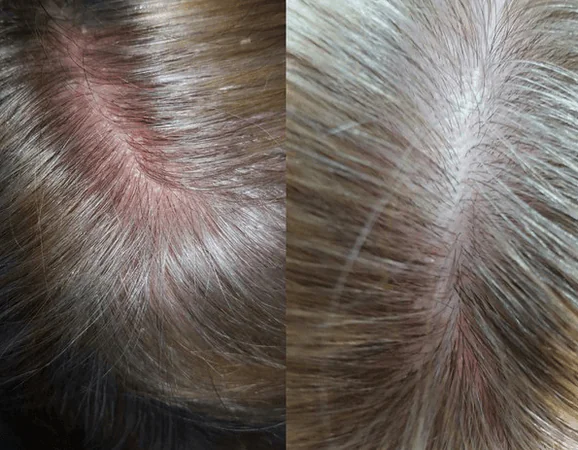
If the cause of the appearance of red rashes on the scalp and itching is the development of an allergic reaction, in most cases it is enough to eliminate the allergen and provide proper care to the skin. In cases where the source of the occurrence is another disease, consult a doctor immediately. With scalp dermatitis, the red spots begin to itch, but the same manifestations can be observed in psoriasis, seborrhea or lichen.
You should not try to fix the problem yourself, since the symptoms can indicate many diseases. Without knowing the cause of the disease, you can aggravate the condition, leading to irreversible consequences.
Psoriasis is the scourge of the modern world: sores or red spots appear on the scalp, photo
In most cases, psoriasis affects people in a chronic form with rare relapses. Red, scaly spots do not appear on the head immediately, gradually spreading over the skin. If the progression of the disease is not prevented, the affected area will increase. The appearance of such spots may also be accompanied by skin irritation and severe itching, as an inflammatory process occurs in the tissues.
Psoriasis can begin to develop in the human body in the presence of the following factors:
- poorly developed immune system;
- genetic predisposition to the disease;
- drug, alcohol and smoking abuse;
- frequent stress;
- suffered head injuries.
It is impossible to completely cure psoriasis, but it is possible to transfer its focus to a “quiet course”. Treatment of redness, itching and inflammation occurs with the help of medications based on tar and ketoconazole. As additional therapy, the doctor may prescribe physiotherapy and a health resort course.
If other infectious diseases were identified during the treatment, antibiotics are prescribed, and if the patient is morally exhausted, he is prescribed psychotropic drugs that help relieve stress and improve sleep.

Psoriasis does not pose a threat to human health and life, but it causes a lot of aesthetic defects, especially in men. It is almost impossible to hide red spots and flaking with a short haircut.
Red spots appeared on the head: causes and symptoms
In cases where the head itches and the skin turns red, not everyone pays attention to these processes, since there are many reasons for itching. Most of them are natural and do not carry any consequences.
But there are cases that itching and the appearance of dandruff are the first signs of the development of infectious diseases: psoriasis, dermatitis and others. The reason for their formation may be:
- frequent stress;
- wrong lifestyle;
- poor nutrition;
- weakened immune system;
- genetic predisposition.
The skin begins to itch due to an inflammatory process in the affected areas. To reduce itching, the doctor prescribes medications and adjusts the patient’s lifestyle: the frequency of hygiene procedures, nutrition and activity of the person during the day.
Traditional treatment and folk recipes
Redness and itching are treated by using complex therapy to eliminate the source of occurrence. The patient takes prescribed medications and undergoes physical therapy; in such situations, specialized sanatoriums are recommended.
In most cases, the doctor prescribes sedatives, antihistamines and hyposensitizing drugs. They are highly toxic and cannot be taken without prescription.
Herbal decoctions and tinctures according to folk recipes can help with itchy red spots on the head. Despite their harmless composition and healing properties, they cannot be used as the main drug for treating the disease.

Red spots appear on the head and are flaky: seborrheic dermatitis
Red spots do not always appear on the head due to the development of infectious diseases or the ingestion of allergens that provoke an allergic reaction.
Seborrheic dermatitis is one of the common skin diseases that require timely treatment. The following symptoms are characteristic of it: itching, irritation, redness of the scalp. Seborrheic dermatitis can also manifest itself with other symptoms:
- red spots or a pinkish tint form on the skin;
- hair fall out;
- the greasiness of the skin increases;
- Frequent itching appears in certain areas or throughout the head.
During peeling, dandruff of an unusual yellowish tint forms on the affected areas. This process occurs very actively and abundantly, so it is impossible to remove scales with ordinary shampoo. With seborrheic dermatitis, not only the spot on the head can peel off, but also the affected areas of the mustache, beard, and eyebrows.
Red spots itchy on the head: how to fight, treatment of seborrhea
Red spots and dandruff on the scalp may be the first signs of the development of seborrheic dermatitis. Only a dermatologist can diagnose the disease and prescribe further therapy. The specialist will recommend reconsidering your lifestyle, as well as replacing your hair shampoo with one more compatible with your skin type.
Flaky red patches on the scalp most often appear due to a weakened immune system that is unable to fight off infection. To normalize it, appropriate medications are prescribed. During the treatment period, you should stop smoking and drinking alcoholic beverages and include more vitamin-rich foods in your daily diet.
Allergy as it is: red spots on the head
Red spots that appear on the head can cause the development of not only infectious diseases, but also the entry of an allergen into the human body, provoking a corresponding reaction.
In such cases, you should not self-medicate, since only a doctor after an examination can determine the real source. Symptoms similar to an allergic reaction are observed with:
- hives;
- cold type;
- erythema on the head in men.

It is worth noting that atopic dermatitis, like eczema, are chronic allergic diseases. There is no point in delaying their treatment - red spots on the scalp begin to itch more and more every day, affecting large areas of the skin.
Red spot on the head and hair loss – fungus
Fungal diseases are common throughout the world. They can arise for various reasons, manifesting themselves in different ways. If skin diseases such as seborrhea or psoriasis are not transmitted from a carrier to a healthy person, then the fungus can spread in the community.
If you suspect you have a fungal disease, take appropriate measures to protect your family from possible infection.
Terrible trichophytosis or ringworm
This disease is the most severe form of the infectious type, the treatment of which is long and difficult. During the development of the fungus, islands appear on the scalp where hair cannot grow, thereby forming bald spots.
The spots turn red, black spots and inflammation appear. At the first suspicion of the development of ringworm, consult a doctor immediately. This disease develops quickly, and failure to provide timely assistance can lead to serious consequences. You can learn more about this disease and its treatment in this article.
Treatment of red skin, peeling and inflammation in most cases occurs with the use of medications. Most of them have a high degree of toxicity - it is strictly forbidden to take them without a doctor’s decision.
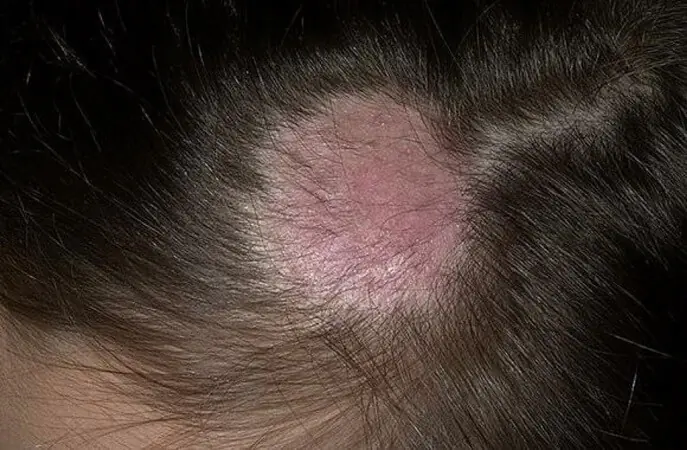
Regardless of the source of the development of fungal and infectious diseases on the skin, do not neglect treatment.
Timely assistance will help quickly eliminate the disease with minimal consequences after its disappearance. By adhering to general hygiene rules, you doom yourself to a long and happy life without psoriasis, seborrheic dermatitis, lichen and other skin diseases.
Content:
Causes of itching on the head in women
The reason most often lies in rather banal care - be it hair dyeing or a new shampoo. However, some itchy conditions (seborrheic dermatitis, for example) most often occur on oily skin, while others, such as contact dermatitis, occur on sensitive and dry skin. But most often the reason is much simpler:
Coloring
Women are experimenting with hair color to achieve fashionable shades this season, trying in any way to get rid of last season's out-of-fashion look. Others simply paint over their gray hair. In both cases, after such procedures, itching appears - a reaction that is especially common when dyeing at home. In salons, professionals apply dye evenly to the hair, but at home, a lot of dye gets on the scalp, resulting in irritation that burns and itches.
Dry skin
Often, when we moisturize our hair, we forget about our skin. And its dryness is the result of dehydration of the sebaceous glands that produce oil, causing the head to itch. The reason for this may be too frequent (or, conversely, infrequent) hair washing:
- Washing too often dries out the skin.
- When you wash too infrequently, sebum accumulates, causing flaking or itching.
Natural emollients are great for protecting natural moisture. Jojoba oil is similar in composition to sebum and is an excellent natural moisturizer.
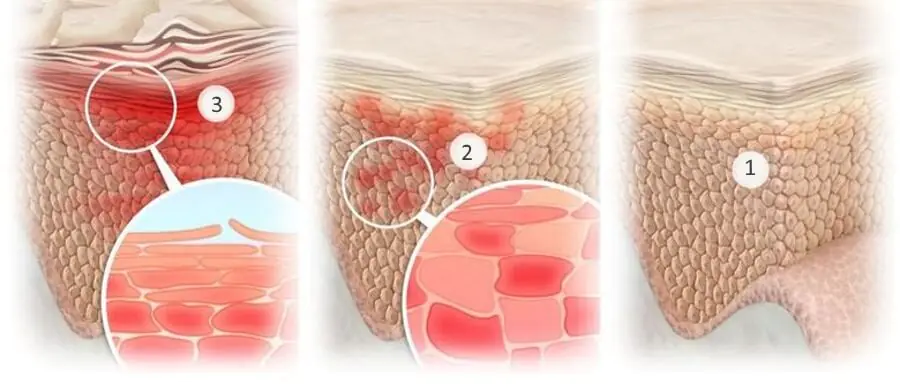
Styling products
If there is no dandruff, the cause of the itching may be hair styling products, which some women use in excess. Some gels, creams, balms, foams and sprays can accumulate on the scalp and form tiny itchy flakes.
Itching from stress
When the body is not under excessive stress, the nervous system and sensory organs function normally. Stress forces the body to activate a defensive reaction, and dissonance arises between the functioning of the nervous system and sensory organs. The result is a wide range of neural sensory symptoms. For example, a burning and itching sensation on the skin of the body, a very itchy head.
In this case, the itching itself is not dangerous and does not need to be treated. As stress subsides, this symptom decreases and eventually disappears. But reducing stress in the body often takes much longer than we think.
However, once the body has fully recovered from the overstimulation of the stress response, this burning and itching sensation on the skin will completely disappear.
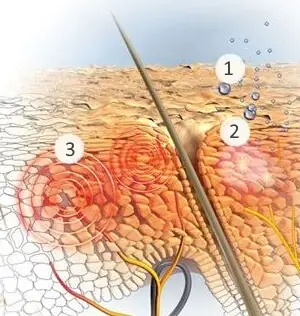
Diseases
In some cases, the problem is a symptom of a more serious disease that needs to be treated with medication, having first been examined by a doctor:
- If thick, scaly patches appear on your scalp that hurt, crack, and bleed, this is psoriasis, a chronic autoimmune disease.
- If, along with itching, hair falls out or breaks, there is liquid discharge that dries into a crust or even pus - this is most likely a staphylococcal infection.
Psoriasis
Psoriasis is a common disease accompanied by redness and peeling of the skin. Usually with psoriasis the scalar is much thicker and more pronounced than with dandruff. It often requires prescription medications to control it.
In this case, shampoos containing coal tar or salicylic acid with mineral oils are suitable to help soften and remove flakes. Dermatologists often prescribe topical steroid medications—liquids or foams that dry quickly and don't tend to weigh down the hair, and can be very helpful in combating dryness, itching, flaking, irritation, or rashes.
Inflammation of hair follicles
Inflammation of the hair follicles or bacterial infection of the scalp can also cause itching, often leading to serious scalp conditions. In this case, doctors advise using natural, organic products to avoid potential allergies to ingredients that could aggravate the problem.
Pediculosis
Diagnosis of lice is perhaps the simplest. It is not difficult to detect the presence of parasites. And it all starts with a rather characteristic itch. In this case, you can choose an over-the-counter medicated shampoo aimed at soothing the skin and getting rid of parasites.
It is best to consult a doctor, but if you decide to choose your own shampoo, then if you have sensitive skin or allergies, look for a remedy that is hypoallergenic and not too aggressive.
Keep in mind that head lice can transfer to bedding and other household items, so regular and thorough cleaning and washing is recommended to completely eradicate the problem and prevent re-infestation.
Scalp irritation, itching, flaking and redness: seborrhea
Dandruff is the main culprit of irritation, accompanied by itching, flaking and redness of the scalp. It is caused by many things, including overproduction of oil or other secretions, as well as overgrowth of yeast, which usually lives on the scalp and other hairy areas. The yeast overgrows and feeds on dead skin cells and oils, leading to itching and flaking.

Seborrheic dermatitis is a common cause of dandruff. Skin oil blocks dead cells that stick together. Hence the scales along the entire length of the hair.
According to doctors, seborrheic dermatitis most often occurs in three phases of life:
- The first three months after birth, when the activity of the sebaceous glands is temporarily high due to the effects of prolonged hormones in the mother after birth.
- During puberty, when the activity of the sebaceous glands is high due to a new influx of hormones.
- In women after 50 years of age, this is when the activity of the sebaceous glands begins to decline.
In this case, dandruff is not curable, but there are several ways to control it. Products containing zinc pyrithione or selenium sulfide are often the most beneficial, such as Clear Complete Scalp Care anti-dandruff shampoo or the well-known Head & Shoulders.
Many women also report relief from symptoms after some home treatments. Doctors advise using coconut oil: rubbed into the scalp at night, it perfectly relieves itching and irritation.
To properly control dandruff, you need to eliminate the fungal component without causing more irritation and redness.
- For mild cases, it is best to use an over-the-counter shampoo that contains selenium, zinc pyrithione, or tea tree oil—they help control the yeast infection.
- If there is no itching, but only flaking and redness, try shampoo with salicylic acid.
- More persistent cases may require a prescription antifungal shampoo or cortisone foam, or, in particularly severe cases, antifungal tablets.
The right shampoo against itching and flaking of the scalp
Severe and persistent itching on the scalp is associated with several different problems, so choosing the best shampoo for treatment should begin with determining the cause. This will give you a starting point when shopping for the product you need. In addition, shampoos for the care of itchy skin are available in various formulas, so you need to carefully read the labels before purchasing, having first determined your skin type.
You or a medical professional can determine the cause of itching by looking at signs that are typical for a particular problem. However, if the itching is accompanied by other symptoms (severe peeling, the appearance of a crust on the head, bleeding, etc.), then it is better to immediately consult a doctor and not self-medicate.
Improper care
Since itching is sometimes associated with skin problems caused by improper care, it is recommended to choose a shampoo based on your hair type. Dry scalp should be treated with a shampoo that can moisturize the skin and hair. Replacing your regular shampoo with a moisturizing one can be a simple solution to relieve symptoms. A moisturizing conditioner can also help relieve itching caused by dry skin.
Insufficient hygiene
Poor hygiene can also lead to itching and if this is the cause, the solution is simple - regularly cleanse your hair and skin with a suitable shampoo to avoid itching caused by dirt and sebaceous gland secretions. If you have oily hair, you can use shampoo daily to maintain proper conditioning. Normal to dry hair usually requires washing every other day to maintain cleanliness.
The most serious causes are contact dermatitis and dandruff, also known as seborrheic dermatitis or simply seborrhea. Only a medical specialist can correctly diagnose and recommend the necessary treatment. In addition, head lice, dry scalp and poor hygiene can also lead to itching and even severe flaking of the skin.

Shampoos for seborrhea
If you know why your head itches very much, and the reason for this is dermatitis, special medicated shampoos will help you effectively cope with the problem. Severe cases of the worst may require the use of prescription shampoos, which can only be prescribed by a doctor. Choosing this type of shampoo for itchy skin is recommended only for the most advanced scalp problems:
- Shampoos containing selenium sulfide. This antifungal agent targets a specific yeast - Pityrosporum ovale. Reduces dandruff on the scalp and relieves irritation and itching. Shampoos on the market containing this ingredient include Selsun Blue and Head & Shoulders Clinical.
Shampoos containing pyrithione zinc, which has both antimicrobial and antifungal properties. Helps cope with inflammation and itching. Pharmacies sell over-the-counter medications that range in strength from 1 to 2 percent, such as Mountain Falls.
Shampoos containing salicylic acid. Salicylic acid has not been as well studied for seborrheic dermatitis as other ingredients. It is believed to be effective in combination with other treatments.
Salicylic acid is the active ingredient in Neutrogena T/Sal Therapeutic, a shampoo specifically formulated to combat the buildup of dead skin cells on the scalp.
Shampoos containing ketoconazole. This ingredient has been well studied for the treatment of dandruff and related conditions. It prevents the growth of fungus and has a mild anti-inflammatory effect. Present in Nizoral anti-dandruff shampoo.
Once the initial severe symptoms pass, seborrheic dermatitis can be managed by using ketoconazole shampoos only once or twice a week.
Ketoconazole is considered safe. Studies have not shown that it irritates the skin or causes other side effects.
Research has shown that coal tar is as effective as ketoconazole due to its ability to reduce fungal growth. Shampoos containing this ingredient include Neutrogena T/Gel Extra Strength, PsoriaTrax, and MG217.
The best diet for an itchy scalp
To combat dry skin in general (including on the head!), you need a balanced diet:
- Omega-3 fatty acids, found in fish, flax seeds and some nuts, are known to help the body fight dry skin (as well as fatigue, moodiness and poor memory). Introducing more foods with omega-3 fatty acids (or fish oil supplements) will also help against itchy dryness.
Zinc is another assistant in the restoration of skin tissue, including on the head. Seafood, meat, poultry, nuts and whole grains are excellent sources. Pharmacies also sell supplements.
Vitamin A is another key element in the overall health of human skin. It supports blood circulation and the immune system. Good sources of vitamin A include eggs, butter, and orange and yellow fruits and vegetables.
Vitamin B supports healthy skin cell production. Sources include meat, poultry, greens, beans and whole grains.
Vitamin C promotes collagen production in the skin, keeping skin hydrated and healthy. Present in abundance in spinach, Brussels sprouts, kiwi, strawberries and citrus fruits.
Of course, you can take a multivitamin to get the right dose of all these skin-preserving supplements. Drink plenty of water and de-stress (easier said than done?) and your skin will thank you.Itching of the scalp is a permanent or temporary sensation of irritation of the skin area, causing us a lot of inconvenience. In most cases, itching manifests itself as a response of the body to an irritant, but in some situations this phenomenon may indicate the presence of any diseases. Severe itching of the scalp in a constant form can lead to thinning of the skin, scratching can lead to damage in the form of cracks, as well as inflammation if infection occurs.
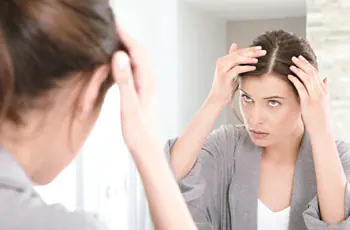
It should be noted that skin itching cannot be ignored, especially in cases where it is accompanied by severe hair loss or the appearance of sores or red spots on the skin. It is important to identify the cause of this phenomenon, for which you should consult a dermatologist and trichologist, who, after diagnosis, will prescribe optimal therapy. In most cases, itchy scalp can be successfully treated at home. As a rule, after eliminating the source of irritation (irritant), the itching itself goes away.
Causes of skin itching.
In medical practice, the most common causes of itchy scalp are:
Parasites (lice, ticks, etc.).
To exclude the possibility of a parasitic infection (for example, pediculosis (lice) or demodicosis (acne)), you should visit a dermatologist. At home, just in case, you can ask your loved ones to look at the skin and hair at the roots using a magnifying glass.
Dandruff.
The occurrence of dandruff often leads to severe and debilitating skin itching. To eliminate it, they often begin to use any available methods and methods, which often do not alleviate the condition, while the underlying disease (dandruff) in most cases is not taken into account, which is completely unacceptable, since the source of its appearance is a violation of the process of sebum formation. This, in turn, without proper treatment can lead to the development of a more serious disease - seborrheic eczema. Therefore, if dandruff appears accompanied by itchy skin, you should consult a trichologist, who will prescribe appropriate treatment, including diet, immunomodulators, medicated shampoos, and medications.
Seborrhea (seborrheic dermatitis).
This skin disease is caused by a malfunction of the sebaceous glands: dry seborrhea is a consequence of decreased activity of the sebaceous glands, oily seborrhea occurs against the background of excessive secretion of sebum with a disturbed chemical composition. Dry seborrhea is accompanied by dandruff, severe itching of the scalp, and acne on the skin.
Allergic reactions to shampoo and other hair care products.
Often the skin begins to itch severely when changing hair care products or products (mask, conditioner, shampoo, conditioner, styling or coloring products). If itching appears immediately after using a new care product, it is recommended to return to the previously tested old one, or try another product that does not contain substances such as, for example, sodium laureth or sodium lauryl sulfate (usually the packaging of such products says “hypoallergenic”). . This is often the source of itching. If the itching does not disappear after changing the shampoo, you should consult a trichologist who will diagnose the scalp and test for allergic reactions.
Hair dye allergies are also common and can cause itchy skin. Typically, paints containing ammonia and hydrogen peroxide cause an allergic skin reaction. Therefore, to prevent this phenomenon, it is recommended to give preference to tinted shampoos and ammonia-free paints. But even in this case, no one is immune from allergies. I would like to add that before any procedure, be it hair coloring or a cosmetic procedure, always do an allergy test. If the scalp is still itchy and itchy after dyeing, you can use special dye-neutralizing shampoos; they are applied after washing off the dye. It is recommended to wash your hair with them after washing off the dye.
An allergy to detergent (washing powder) or fabric softener can also cause irritation and, accordingly, itching of the scalp.
Frequent washing and use of hair drying and styling devices.
Many women, without knowing it, provoke the appearance of itchy skin. And frequent hair washing is no exception. In addition, regular use of hair dryers, straighteners and many other hair devices not only dry out the skin, but also negatively affect the condition of the hair itself.
In such cases, it is necessary to avoid frequently changing brands of hair care products, use proven products, and always monitor the condition of the scalp. At the slightest hint of itching or burning, you should immediately stop using them.
Dry skin.
With an insufficient amount of sebum, hair becomes dry and brittle, begins to become very electrified, frizzy, difficult to style, and quickly absorbs moisture. It happens that an excessively dry scalp suddenly begins to produce more oil. This is just a protective reaction of the skin from possible negative influences from the outside, but it is often taken as excessive oily roots, as a result of which they begin to use oily hair care products. All this makes hair and skin even drier. In this situation, experts insist on the use of special moisturizing shampoos, balms, masks and intensive moisturizing creams.
Also, itchy skin can occur due to a lack of unsaturated fatty acids, vitamins, and microelements in the body.
Fungal diseases of the scalp.
Fungal infections also cause severe itching. In this situation, experts recommend doing a fungal culture, according to which a course of treatment is prescribed, including the use of medicated shampoos and lotions, as well as antifungal drugs (Clotrimazole, Griseofulvin, Miconazole). In addition, patients are recommended to use a special Ketoconazal shampoo when washing their hair, which contains selenium sulfide. In some cases, drugs to strengthen the immune system are also prescribed. If you don’t have the opportunity to visit a specialist, pharmacy antifungal drugs, which contain components such as piroctone olamine, zinc pyrithione, climbazole and others, will help you cope with a fungal disease of the scalp.
Various stress factors.
Stressful situations (psychological pressure, mental or physical stress, emotional instability, illness or death of loved ones) have already been proven to also be a source of itching of the scalp. Due to stress, the body experiences excessive production of adrenaline. To remove the latter from the body, physical activity is necessary. If there are none, adrenaline begins to accumulate in the blood, which leads to debilitating itching of the skin.
Dermatophytoses (lichen).
Ringworm is a contagious fungal skin infection. This problem is common among children who are in contact with children's groups or infectious animals. The main signs of lichen are the appearance of severely itchy lesions on the scalp, in the area of which the hair is broken off or completely falls out.
Muscle tension.
Itching of the skin can also be a consequence of excessive muscle strain. Most often, itching is provoked by tension in the muscles of the back, shoulders, and neck, against the background of which blood microcirculation also deteriorates. In addition, constant tension in the head muscles can provoke microtraumas of muscle fibers, which can result in an inflammatory process, which is also accompanied by intense and incessant skin itching.
In especially severe cases, itching occurs due to intense hair loss. In this case, the doctor will be able to provide assistance through special intensive therapy aimed at relaxing the muscle fibers of the head.
Treatment of itchy scalp.
Since itching is just a consequence or a symptom, to treat it it is necessary to identify and eliminate the cause that caused it. In this case, you need the help of a specialist who, after a complete diagnosis (various studies taking into account clinical manifestations and the specific case), will prescribe the optimal treatment.
If the cause of itching turns out to be elementary parasites (for example, lice), then to remove them you should purchase modern effective remedies for such parasites at the pharmacy (Nittifor (solution or cream), Para Plus aerosol, Pediculen lotion.). After removing lice, you should also get rid of nits by using a fine comb. It is also recommended to check other family members for the presence of lice, and the patient’s clothes and bedding should be boiled and ironed with a hot iron. In this case, I would not recommend resorting to traditional methods (using, for example, kerosene), they not only will not help, but can also cause harm. Unlike lice, it is somewhat more difficult to determine the presence of demodicosis, but the doctor will do it in a matter of seconds. To treat demodicosis, you must consult a doctor; only he can prescribe medications.
Treatment of seborrhea is a long and complex process. Proper nutrition, avoidance of stress, hormonal balance (disturbances can provoke seborrhea), adherence to sleep and rest schedules are important in the treatment of the disease. In addition, it is important for patients to keep their scalp clean.
For dry skin, nourishing masks will be useful; they will have a softening effect and improve microcirculation. It is also of great importance to adhere to the drinking regime (at least one and a half liters of water per day), which will prevent dehydration.
If the itching is caused by a lack of vitamins and microelements, you should take a course of vitamins (Vitrum, Complivit, Alphabet, Centrum, etc.).
Treatment of itching with folk remedies.
Herbal medicine and massage are especially effective for treating the scalp. Decoctions of medicinal herbs have long been used to normalize the functioning of the sebaceous glands. Decoctions and extracts of nettle, oak bark, and chamomile are especially beneficial for the skin. Massage activates blood circulation, which, in turn, improves skin nutrition.
Onion and garlic juice, due to their sulfur and acid content, effectively eliminate dandruff and relieve itching caused by hair coloring. Add lemon juice and vegetable oil (preferably olive) to freshly squeezed onion or garlic juice; take everything in equal proportions. Apply the resulting composition to wet hair and skin and leave for half an hour, then rinse with warm water adding a small amount of lemon juice or vinegar.
For the same purposes, it is effective to use an apple mask. Grind one medium-sized apple on a coarse grater. Grate a large apple and apply the resulting mixture to your hair and scalp before washing. Put a cotton cap on top. Leave the mask on for half an hour and wash off. Recommended for use twice a week.
Dandelion flower lotion is also effective in relieving itchy scalp. Grind a handful of fresh dandelion flowers and place in a glass container. Pour this herbal mass with 50 ml of vodka, the juice of one freshly squeezed lemon and a teaspoon of honey, preferably in liquid form. Mix everything thoroughly and leave to infuse for two weeks. After the specified period, the resulting tincture must be filtered. Half an hour before washing, apply the infusion to the skin and hair, and put on a cotton cap or scarf on top. After the time has passed, wash your hair with shampoo.
Onion peels are also good to use for the same purposes. Wash the peels from four onions and place them in an enamel bowl with a liter of boiling water. Place the mixture on the fire and simmer for an hour over low heat. Use this decoction as a rinse after washing your hair. The decoction helps after two or three times of use.
If these simple methods do not relieve the itching, it is recommended to consult a doctor in order to rule out more serious skin problems and diseases.



